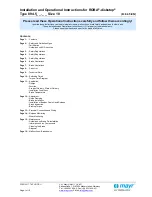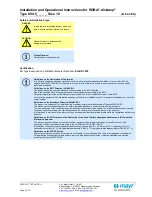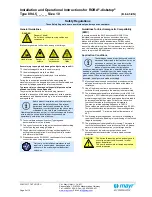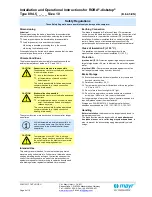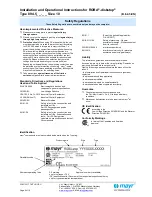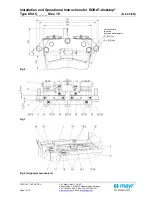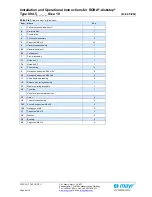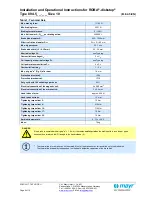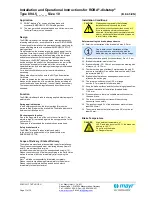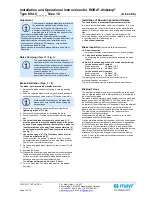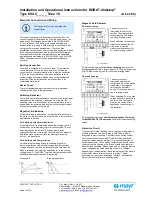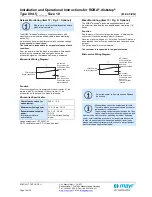
Installation and Operational Instructions for ROBA
®
-diskstop
®
Type 894.5_ _._ _ Size 10
(B.8.4.5.EN)
23/03/2017 TK/TL/GC/SU
Chr. Mayr GmbH + Co. KG
Eichenstraße 1, D-87665 Mauerstetten, Germany
Tel.: +49 8341 804-0, Fax: +49 8341 804-421
Page 15 of 16
www.mayr.com
, E-Mail:
info@mayr.com
Maintenance
The ROBA
®
-diskstop
®
is mainly maintenance-free.
The friction lining pairing is robust and wear-resistant. This
ensures a particularly long service lifetime of the brake.
However, the friction linings are subject to functional wear.
Therefore, please carry out regular friction lining inspections.
The friction pads (4) must be replaced when air
gap “a” > 1.8 mm (Fig. 2) is reached between
the coil carrier (1) and the armature disk (2) on
a warm brake.
Replacement of the friction pads (4) and all other maintenance
work must be carried out at the place of manufacture.
Guidelines on Brake De-installation
Before carrying out brake de-installation (e.g.
brake change), all cap screws (17) must be
loosened.
Information on the Components
The
friction material
contains different inorganic and organic
compounds, which are integrated into a system of hardened
binding agents and fibres.
Possible hazards:
No potential dangers have been recognised so far when the
brake is used according to its intended purpose. When grinding
in the friction linings (new condition) and also in case of
EMERGENCY STOP braking actions, functional wear can occur
(wear on the friction linings); on open brake designs, fine dust
can be emitted.
Classification: Hazardous property
Attention: H-classification: H372
Protective measures and rules of behaviour:
Do not inhale dusts
Vacuum the dusts at the point of origin (tested suction devices,
tested filters acc. DIN EN 60335-2-69 for dust classes H;
maintenance of the suction devices and filter replacement at
regular intervals).
If local dust suction is not possible or is insufficient, the entire
work area must be ventilated using appropriate technology.
Additional information:
This friction lining (asbestos free) is not a dangerous product in
terms of the EU Directive
Cleaning the Brake
Do not clean the brake using compressed air,
brushes or similar devices!
Use a suction system or wet towels to clean off the brake
dust.
Do not inhale brake dust (wear safety gloves / safety
goggles)
In case of dust formation, a dust mask FFP 2 is
recommended.
Disposal
Our electromagnetic brake components must be disposed of
separately as they consist of different materials. Please also
observe the relevant authority regulations. Code numbers may
vary according to the disassembling process (metal, plastic and
cables).
Electronic components
(Rectifier / ROBA
®
-switch / Microswitch):
Products which have not been disassembled can be disposed of
under Code No. 160214 (mixed materials) or components under
Code No. 160216, or can be disposed of by a certified disposal
firm.
Brake bodies made of steel with coil/cable and all other
steel components:
Steel scrap
(Code No. 160117)
All aluminium components:
Non-ferrous metals
(Code No. 160118)
Friction pads (steel or aluminium pads with friction linings):
Brake linings
(Code No. 160112)
Seals, O-rings, V-seals, elastomers, terminal boxes (PVC):
Plastic
(Code No. 160119)

